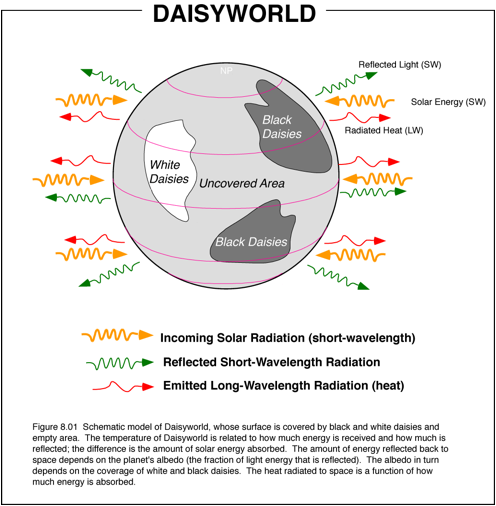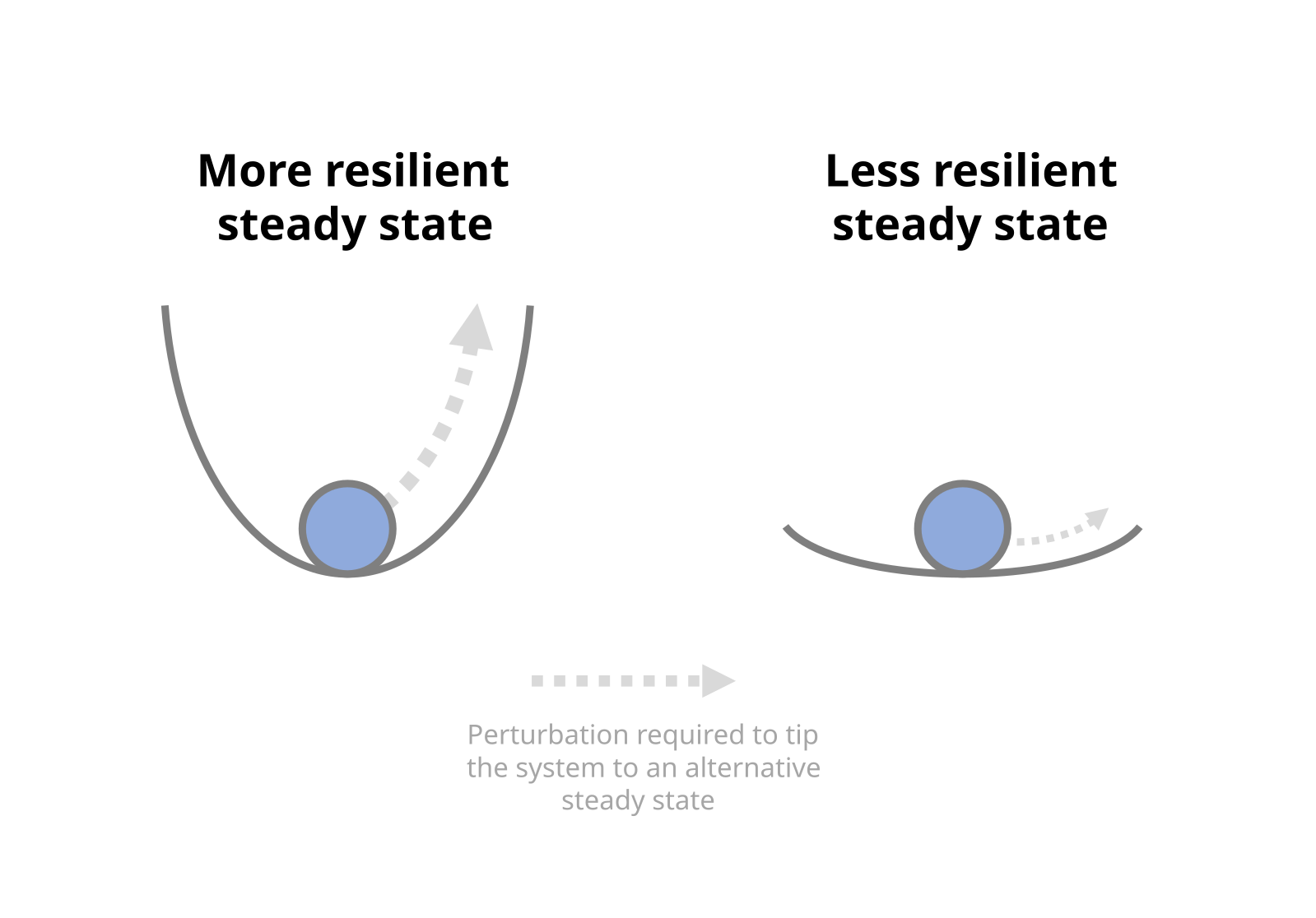IB Syllabus focus:
‘Negative feedback reduces change, stabilizing systems (e.g., Daisyworld temperature regulation). Ecosystems often hold steady-state or developing equilibria maintained by stabilizing feedbacks; disturbance tends to return systems toward prior states.’
Negative feedback processes are vital in environmental systems, working to stabilise ecosystems and maintain balance. They counteract fluctuations, returning systems towards equilibrium despite disturbances.
Understanding Negative Feedback
Definition of Negative Feedback
Negative Feedback: A process where a change in a system triggers responses that counteract the original change, reducing its effect and stabilising the system.
Negative feedback mechanisms reduce change and promote stability, ensuring that environmental systems do not spiral out of control when exposed to external disturbances. This is essential for long-term ecosystem resilience.
Daisyworld Example
The Daisyworld model is often used to illustrate negative feedback in regulating temperature.
When global temperatures rise, white daisies reflect more sunlight, cooling the planet.
When temperatures fall, darker daisies absorb more heat, warming the planet.
Together, these feedbacks help regulate the planet’s temperature near an equilibrium range.
This demonstrates how simple biological processes can contribute to large-scale environmental stability.
Negative feedback reduces change, stabilizing systems (e.g., Daisyworld temperature regulation).

Labeled schematic of the Daisyworld model showing white and black daisies, incoming short-wave radiation, reflected short-wave radiation, and emitted long-wave heat. The diagram illustrates how contrasting albedos create stabilising feedback on planetary temperature across changing solar luminosity. The image focuses on core Daisyworld mechanics without extraneous detail. Source.
Equilibrium in Environmental Systems
Definition of Equilibrium
Equilibrium: A state of balance in a system where inputs and outputs are equal, and the system remains stable over time.
In ecosystems, equilibrium does not mean that conditions remain constant, but rather that fluctuations are balanced by stabilising feedbacks.
Types of Equilibria
Environmental systems can exhibit different forms of equilibrium:
Steady-State Equilibrium: The system remains stable over long time periods with minor fluctuations balanced by negative feedback. Example: predator–prey cycles where population sizes oscillate around a mean.
Developing Equilibrium: The system changes gradually over time but remains balanced in its development. Example: natural succession from bare soil to a mature forest.
Both steady-state and developing equilibria rely on negative feedbacks to maintain order despite ongoing changes.
Ecosystems often hold steady-state or developing equilibria maintained by stabilizing feedbacks; disturbance tends to return systems toward prior states.

Ball-and-valley analogy of system stability: deep valleys represent resilient steady states maintained by negative feedback, while shallow valleys represent less-resilient states. Small perturbations roll the “system” (ball) back to equilibrium; larger pushes can cross a threshold into an alternative regime. This diagram includes general stability concepts aligned with the syllabus. Source.
Negative Feedback in Ecosystem Regulation
Stabilising Populations
Negative feedback mechanisms regulate population sizes in ecosystems.
When prey numbers increase, predator populations rise, consuming more prey.
As prey decline, predator numbers fall, allowing prey to recover.
This cycle maintains balance and prevents uncontrolled growth or collapse.
Nutrient Cycles
In nutrient cycles, negative feedback ensures balance in storage and flow:
Excess nutrients stimulate plant growth.
Increased uptake of nutrients by plants reduces the surplus, restoring balance.
This is critical for maintaining soil fertility and ecosystem productivity.
Climate Regulation
Negative feedback helps regulate climate conditions:
Increased atmospheric CO₂ can enhance plant growth (carbon fertilisation), which draws down CO₂ levels.
This reduces the intensity of warming, although the effect has limits.
These processes illustrate how ecosystems self-regulate to counteract disturbances.
Disturbance and Return to Prior States
Resilience and Recovery
When ecosystems are disturbed—by storms, fires, or human activity—negative feedback often allows them to return towards their prior states. For example:
After a fire, vegetation regrows, stabilising soil and restoring ecosystem functions.
After flooding, wetland plants re-establish, preventing long-term destabilisation.
This resilience is crucial for sustaining biodiversity and ecosystem services.
Limits to Negative Feedback
While powerful, negative feedback mechanisms have limits:
Intensity of disturbance: If disturbances exceed system capacity, equilibrium may not be restored.
Loss of diversity: Reduced biodiversity weakens negative feedbacks, lowering resilience.
Human impacts: Activities like deforestation or pollution can disrupt feedback loops, pushing systems towards collapse.
Key Features of Negative Feedback
Self-regulation: Systems adjust internally without external control.
Balance and stability: Reduces extreme fluctuations in system behaviour.
Reversibility: Allows ecosystems to return to prior states after disturbance.
Dependence on diversity: The variety of species and processes enhances stabilising mechanisms.
Case Study: Daisyworld as a Teaching Model
Why Daisyworld Matters
The Daisyworld simulation is widely used in IB Environmental Systems and Societies because it illustrates:
How feedback loops stabilise planetary conditions.
The importance of biodiversity in regulating environmental variables.
The concept of dynamic equilibrium, where stability is maintained despite continuous changes.
Although simplified, Daisyworld provides an accessible model for understanding complex planetary feedback systems.
Summary of Key Concepts
Negative feedback reduces change, stabilising systems.
Equilibrium is balance maintained by stabilising feedbacks, either steady-state or developing.
Ecosystems often return towards prior states after disturbances due to negative feedback.
Daisyworld is a classic model demonstrating feedback and equilibrium regulation.
Human activity can undermine feedback mechanisms, reducing ecosystem stability.
FAQ
Negative feedback reduces change by counteracting fluctuations, leading to stability and equilibrium. For example, predator–prey cycles regulate populations.
Positive feedback amplifies change, moving systems further from equilibrium. An example is ice–albedo feedback, where melting ice reduces reflectivity, causing further warming and more ice loss.
Resilience refers to an ecosystem’s ability to recover from disturbance. Negative feedback strengthens resilience because it brings systems back towards balance.
For instance, nutrient cycling and population regulation help ecosystems absorb shocks such as fire or storms without permanent collapse.
Yes, human activities can weaken stabilising processes. Examples include:
Deforestation reducing vegetation recovery after disturbance.
Overfishing breaking predator–prey balance.
Climate change overwhelming natural carbon uptake.
When feedback loops are disrupted, systems risk crossing thresholds into less stable states.
In steady-state equilibrium, negative feedback keeps conditions fluctuating around a stable mean, such as predator–prey cycles.
In developing equilibrium, negative feedback regulates gradual directional changes, like maintaining balance during ecological succession towards a mature community.
Daisyworld simplifies complex planetary processes into a visual model. It shows how two variables—daisy colour and temperature—interact to stabilise climate.
Though unrealistic, the model demonstrates key principles of feedback, equilibrium, and resilience in a way accessible to students studying environmental systems.
Practice Questions
Question 1 (2 marks)
Define negative feedback in the context of environmental systems and explain its role in maintaining equilibrium.
Mark scheme:
Definition of negative feedback as a process that counteracts change in a system (1 mark).
Explanation that it helps maintain stability or equilibrium by reducing fluctuations (1 mark).
Question 2 (5 marks)
Using examples, explain how negative feedback maintains equilibrium in ecosystems.
Mark scheme:
General explanation of negative feedback as a stabilising process (1 mark).
Reference to equilibrium as balance between inputs and outputs or steady-state conditions (1 mark).
Example 1: Predator–prey relationship (when prey increase, predators increase, which reduces prey population, stabilising system) (1 mark).
Example 2: Daisyworld model regulating planetary temperature via albedo effects of white and black daisies (1 mark).
Clear link between examples and maintenance of equilibrium (1 mark).

